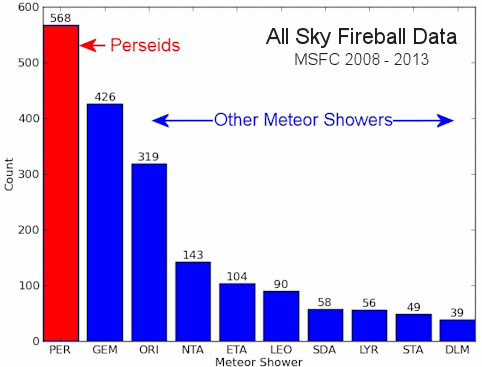2019 August 5
Get out early for this year’s Perseid meteors – and persevere!
The Earth is now inside the stream of dusty debris from periodic comet 109P/Swift-Tuttle, parent of the annual Perseid meteor shower. Consequently, observers are reporting increasing Perseid meteor activity. Indeed, the UK’s NEMETODE network of video meteor cameras is already detecting a few bright Perseids every night and numbers will surely increase in the week ahead.
Only last night (August 3/4), Williiam Stewart’s north facing camera at Ravensmoor picked up a couple of bright Perseids at 01:08:18 and 01:09:50 UT. Not quite fireballs (apparent magnitudes of -3.6 and -3.9), but interesting that William picked up the pair with the same camera within a couple of minutes of each other. Video captures of these events are shown to the right.
The Perseids are one of the most reliable showers of the year, producing an abundance of fast, bright meteors, many with persistent trains. This year, some observers may be put off by the fact that there is a bright Full Moon on August 15, just a couple of days after the peak of the shower – predicted for just after dawn UK time on Tuesday, August 13. Bright moonlight certainly has an adverse effect on meteor observing, lunar glare swamping out all but the brighter meteors, BUT the good news is that the near Full Moon will be low down in Sagittarius. Visual observers may minimize the effects of moonlight by positioning themselves so the Moon is behind them and hidden behind a wall or other suitable obstruction. This is easiest when the Moon is fairly low in the southern sky as it will be for the Perseids this year.
The other good news is that many Perseid meteors are bright and there is a high percentage of fireballs, easily visible in spite of the bright Moon. Indeed, a 6-year study by NASA’s Meteoroid Environment Office (reported on www.spaceweather.com) found that the Perseids produce more fireballs than any other annual shower.

Perseid meteoroids hit the atmosphere at a velocity of almost 60 km/s (133,350 mph). The average magnitude of the resulting bright meteors is -3.7, about as bright as Venus. Interestingly, this is almost exactly the brightness of the two meteors recorded by William Stewart mentioned above. The intrinsic brightness of the Perseids is particularly important this year given the glare from the waxing gibbous Moon. Indeed, the Perseids are an ideal target for digital imaging due to the relative abundance of bright meteors, although exposures will need to be kept quite short because of the moonlight and if you are imaging from a site with any light pollution.
Another way to beat the moonlight is to go out a few days earlier than usual to watch the progress of the shower, on August 9, 10, and 11 when the Moon is less obtrusive, particularly during the early morning hours as the shower radiant at RA 03h 11m, Dec. +58° on August 12/13 (near the Double Cluster, on the Perseus-Cassiopeia border) climbs higher in the eastern sky and observed meteor rates increase.
Perseid activity displays a marked ‘kick’ around August 8-9 and steadily increasing rates are likely from then until the peak, at around 07h UT (08h BST) on Monday, August 13 this year. This means that observations throughout this coming week and over next weekend should be fairly productive. The shower will continue to be active until about August 24.
Please do not be put off by the weather forecast which suggests there will be plenty of showers and thunderstorms during the next week or so. As William Stewart points out it is sometimes the case that after a good thunderstorm or heavy spell of rain, the atmosphere, once the clouds break, is quite clear giving decent views.
Observations in recent years have revealed noticeable variations in activity from year to year and there was a brief but well recorded outburst in Perseid rates in 2016 (see J. Brit. Astron. Assoc. 126(5), 264-265). No such enhancements are expected in 2019, but unexpected activity can never be ruled out.
Meteor observing should be viewed, first and foremost, as a source of enjoyment for the observer(s). Whatever the approach and specific techniques applied, meteor observing can still produce unexpected results, and the only way to make sure you don’t miss out is to go out and observe!
By whatever means you observe the Perseids this year, please submit your results to the BAA Meteor Section via meteor@britastro.org and upload them to your BAA Member Page.
Please note that the Section Director will be away August 12th to 22nd.
Dr John Mason
Director, BAA Meteor Section
email: docjohn@dircon.co.uk
BAA members can read Steve Bosley’s article in the August edition of the Journal on video meteor networks over the British Isles.
[Thumbnail image by Steve Bosley of the Perseid Meteors from 2018.]
| The British Astronomical Association supports amateur astronomers around the UK and the rest of the world. Find out more about the BAA or join us. |
